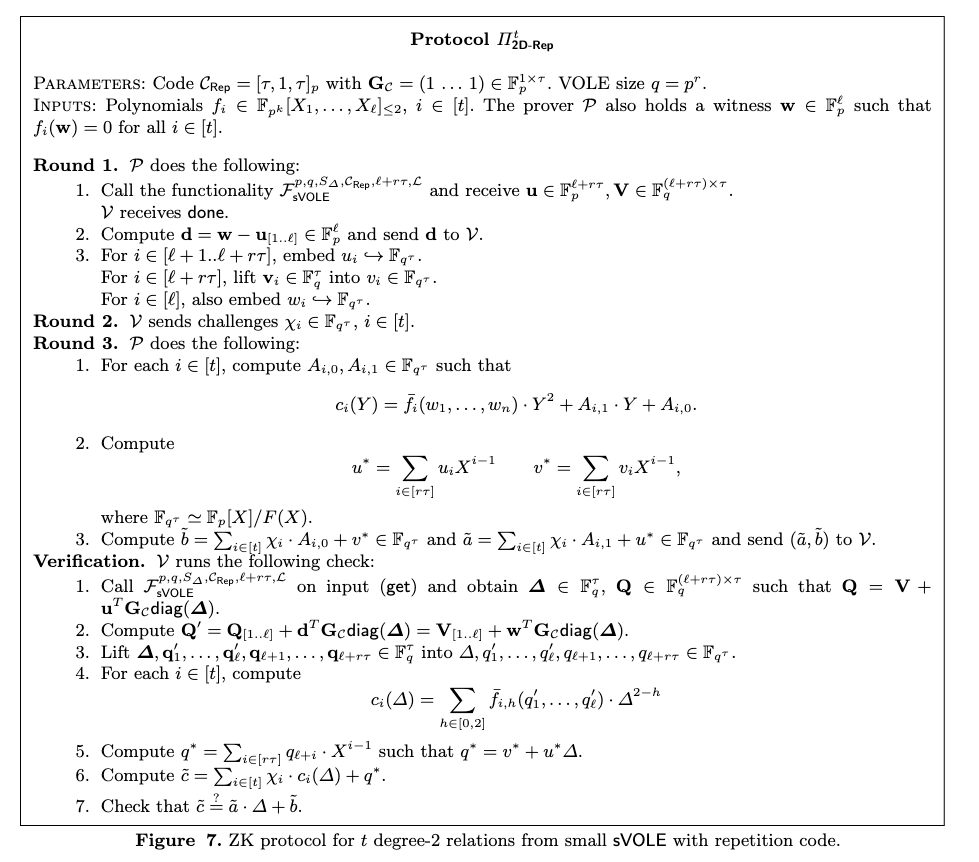I recommend reading them in this order.
Background
Conventional VOLE-based ZKs have limited applications because they are designed verifiers that require interaction to generate VOLE correlations. Therefore, Petter et al. devised VOLE in the Head, a public verifiable VOLE-based ZK based on ‘Quicksilver and MPC in the Head.
The extension to the Public-coin Protocol enabled the use of the Fiat-Shamir transformation, transforming it into a NIZK VOLE-based ZK. Petter et al. propose the PQ Signature scheme: FAEST as an application of VOLE itH, and its further application to a quantum distributed ledger system that is resistant to secret money transfers.
Novelty
- In the existing VOLE-based ZK, Prover and Verifier cooperate to generate VOLE Correlation based on OT, and then Commit&Open is performed, VOLE itH does not generate VOLE Correlation first, but converts it to VOLE Correlation after Commit&Open.
- In Quicksilver, the following design is used. In Quicksilver, Sender: Verifier, Receiver: Prover, but in VOLE itH, Sender: Prover, Receiver: Verifier.
- In the past, VOLE-based ZKs (e.g. Quicksilver) did not reveal the to the prover in order to achieve binding in the VOLE Commitment. This is the reason why it is a Designed Verifier. In VOLE itH, the commitment scheme is made VOLE-independent (hash-based vector commitment), which makes the public. can be made public, and as a result, it has been transformed into a public verifiable protocol.
Now let’s look at the Pros/Cons of VOLE itH. Pros
- Fast proving
- Memory efficient
- Without trusted setup
- Non-Interactive
Cons
- Linear proof size
- Communication cost
Compared to Quicksilver, Communication cost is also reduced, so you should really only focus on Proof size!
All-but-one Vector Commitment
This section describes Vector Commitment, which is important in VOLE itH. The protocol proceeds as follows
- Prover stores the Commitment about wire value: in Leaf of GGM Tree and commits it.
- Verifier randomly picks Challenge: and sends it to Prover.
- Prover sends to Verifier and opens .
- Verifier calculates VOLE Correlation and Verify.
where , and . In Opening, Verifier is given the path of the leaf with , and Verifier derives the leaf (wire value) from it. Since is derived from , Verifier can calculate directly and obtain VOLE Correlation by performing the following calculation after Opening.
If , then the element in low is missing because . In other words, is not valid, so the verification fails. In other words, we can say that this is evaluated in terms other than rather than in terms of .
Since is random, it can be regarded as Public-coin Protocol, and Challenge can be made Non-Interactive by Fiat-Shamir Transformation.Thus, by replacing the Commitment scheme with an All-but-one Vector Commitment based on the GGM Tree, the order of Commitment and VOLE Correlation can be swapped to become Public Verifiable.
Binding-Hiding is secured by a hash function.
Protocol Overview
The entire protocol is as follows.

Strictly speaking, there will be additional Challenges associated with Consistency Check and Fiat-Shamir, which I did not mention in this blog. However, I think it is enough to explain VOLE itH’s motivation to make it Public verifiable.